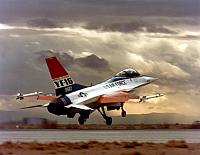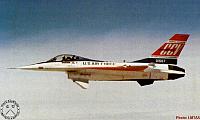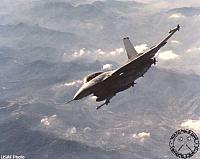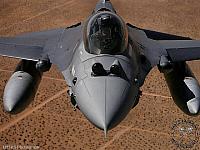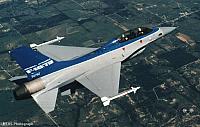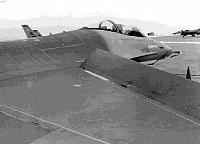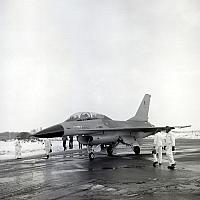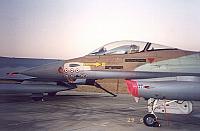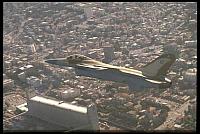| Local S/N |
AF/Unit |
Aircraft |
Name |
Marked |
Date |
Details |
| 01567 |

|
72-1567
|
|
|
20 Jan 1974 |
Details
|
|
|
|
|
YF-16 Prototype
Rolled out at Fort Worth, Texas on December 13th, 1973. First flight on January 20th, 1974 which is the very first flight of an F-16. It had been moved in a C-5 galaxy 12 days prior on January 8th, 1974 and assembled for first flight. The first flight wasn't supposed to happen, but during high speed taxi trials the aircraft lifted off with the only option for the pilot was to proceed and fly. In the first stages the right-hand stab hit the runway a couple of times creating some damage to it.
|
|
| 01567 |

|
72-1567
|
|
|
Dec 1975 |
Details
|
|
|
|
|
Twin Canards
The first YF-16 (#72-1567) was rebuilt in December of 1975 to become the USAF Flight Dynamics Laboratory's Control Configured Vehicle (CCV). CCV aircraft have independent or 'decoupled' flight control surfaces, which make it possible to maneuver in one plane without movement in another - for example, turning without having to bank. To achieve this, the aircraft's flight controls were modified and it was fitted with twin vertical canards underneath the air intake. First flight in the CCV role was on March 16th, 1976 and the tests lasted till July 31st, 1977. On June 24th, 1976 was damaged when the engine failed during a landing cycle. It was repaired but broken again in a hard landing in July of 1977. This cut the CCV tests short.
|
|
| 01568 |

|
72-1568
|
|
|
Feb 1975 |
Details
|
|
|
|
|
Navy F-16
In 1975, the US Navy had expressed interest in a low-cost alternative to the Grumman F-14 Tomcat. General Dynamics proposed a navalized YF-16, with BVR radar, which was not part of the original planning for the USAF. The aircraft was briefly painted in a two-tone blue/light-brown color scheme for naval evaluation purposes. General Dynamics refined the proposal into a single-seat F-16, based on the two-seat F-16B - with the space ordinarily occupied by the rear seat used for increased avionics or fuel. On May 2nd, 1975, the Navy announced that they had decided not to buy the navalized F-16, but opted instead for an aircraft developed from the YF-17, which was eventually to emerge as the McDonnell Douglas F/A-18 Hornet.
|
|
| 01568 |
 USAF 6516 TS
USAF 6516 TS
|
72-1568
|
|
|
Apr 1975 |
Details
|
|
|
|
|
Sparrow Tester
The aircraft used to perform some tests with the AIM-7 Sparrow missile. Only with the introduction of the ADF version of the F-16, a BVR missile capacity was added to the airframe.
|
|
| 75745 |
 USAF 6516 TS
USAF 6516 TS
|
75-0745
|
|
|
29 May 1981 |
Details
|
|
|
|
|
First General Electric powered F-16
Modified as F-16/101 with a General Electric F101 engine and first flight with this engine was on May 29th, 1981. This engine later led to the GE F110 engine installed from block 30 onwards.
|
|
| 75747 |

|
75-0747
|
|
|
02 Dec 1981 |
Details
|
|
|
|
|
From F-16A to F-16XL/B
One of the original F-16A Full-Scale Development aircraft. The aircraft crash landed on Rogers dry lake bed at Edwards AFB due to a blown nose gear tire on take off during the annual open house air show. The pilot survived unharmed but very shaken. It was shipped to General Dynamics Fort Worth in a C-5 and rebuilt into the first cranked-arrow F-16XL, flying back to Edwards one year later on December 2nd, 1981. It was later converted into a dual-seat F-16XL/B. First flight in its new configuration was on October 29th, 1982.
|
|
| 75750 |

|
75-0750
|
|
|
14 Dec 1988 |
Details
|
|
|
|
|
Low-level Battlefield Interdiction Tests
In the late eighties, the Advanced Fighter Technology Integration (AFTI) F-16 testbed (formerly the 6th FDS aircraft) was fitted with a dorsal spine, wing-root mounted Lantirn-style pods, and FLIR turrets on the nose. It was also upgraded with an F-16C block 25 wing and with block 40 F-16C features such as APG-68 radar and a LANTIRN interface.
It was used as a CAS testbed in support of the proposed A-16, testing low-level battlefield interdiction techniques such as automatic target handoff-systems. This program lasted untill January of 1992.
|
|
| 75750 |

|
75-0750
|
|
|
16 Jul 1982 |
Details
|
|
|
|
|
Dorsal Spine
In 1982 the 6th Full-Scale Development (FSD) aircraft was modified as Advanced Fighter Technology Integration (AFTI) testbed, which included the canards from the YF-16 CCV and a dorsal spine. The dorsal spine would eventually make it to some production model F-16s. First program was the Digital Flight Control System (DFCS) in which a total of 108 flights were executed untill July of 1983.
|
|
| 75752 |

|
75-0752
|
|
|
Unknown |
Details
|
|
|
|
|
J-79 Testbed
Modified as F-16/79 with a General Electric J-79 engine. This engine was tested as a low-cost and lower-thrust alternative for non-NATO allies. The project never materialised because the standard Pratt & Whitney F-100 engine was made available to all who could pay for it under the Reagan Administration.
|
|
| 80001 |

|
78-0001
|
|
|
06 Sep 1978 |
Details
|
|
|
|
|
First USAF F-16
This F-16 was the first to roll off the General Dynamics production line at Fort Worth, TX. It was delivered to the USAF in August of 1978 and thus became the very first production F-16 to be delivered worldwide. Initial deliveries went to the 388th TFW at Hill AFB, where initial pilot training on the type was performed.
|
|
| 78044 |
 USAF 34 TFS
USAF 34 TFS
|
78-0044
|
|
|
20 Mar 1982 |
Details
|
|
|
|
|
Landed with failed leading edge flap
In Lt. Col. Pat "Gums" McAdoo's words:
"I was the first Viper pilot to successfully land the thing with a failed leading edge flap. Was early spring/late winter 1982. Maybe 20 March, tail number 044, as that log entry shows 0.3 hours and a precision approach. Weather was not ll that keen. Have the HUD video in VHS format."
"Maintenance troops had failed to insert a 'keeper' bolt that is supposed to keep the flap drive tubes from slipping apart. It's like a cotter key on a bolt. The flap drive motor has a spline gear on it and the drive tube has gear teeth that match up. So the drive tube gradually slipped out from the motor spline gear. When I rotated, the drive tube slid all the way out and the leading edge flap went up until the wing upper surface stopped it. Maybe 50-60 degrees. Another troop had his fail a few months later and the flap went to 90 degrees because he was going a lot faster when the drive tube failed. So I was at 160 knots and holding full left stick. Post-flight data revealed that I had about one pound of control authority for banking left. So I was holding 15-16 pounds of left stick the whole time. "
"I stayed at 170-180 knots, as I could still maintain control and wasn't gonna play Chuck Yeager more than I had to. Nevertheless, I was the first troop to fly the thing in that configuration, so everything was new territory. Bunted over to get opposite flap 2 degrees up and locked the flaps( LEF's go up when bunting over, or when weight is on wheels). I now had both LEF's up, and it seemed to help with the roll authority. Additionally, that other flap wasn't gonna be moving all over the place, and this kept things a little more predictable. "
"Came around on the ILS and landed in one helluva crab. The drag was so great that I almost landed short when I pulled off the power. As I was coming in a lot hotter than normal, I thought I would land long. heh heh, sucker dropped like a rock and I was able to make a mid-field turn off."
Exact date of this mishap is not known, but did happen in 1982.
|
|
| FB-01 |

|
78-0162
|
|
|
26 Jan 1979 |
Details
|
|
|
|
|
First European F-16
This was the first F-16 to be delivered to the Belgian Air Force and also the first F-16 that came off a European production line. In this case the SABCA factory. The aircraft was delivered to Beauvechain/Bevekom AB - home of the 1st Wing - in a wintery January of 1979. This first flight was performed by Col. Jerry Singleton (USAF) and Maj. Guy Devolder (BAF).
|
|
| 107 |
 IDFAF 253 sqn
IDFAF 253 sqn
|
78-0311
|
|
|
Unknown |
Details
|
|
|
|
|
Nuclear Reactor Kill
This Israeli F-16A aircraft was the second of eight aircraft to drop its bombs on the Osirak reactor in Iraq, during the June 1981 attack. It wore 6.5 Syrian kill markings, and an Operation Opera "nuclear reactor" kill mark.
|
|
| 112 |
 IDFAF 117 sqn
IDFAF 117 sqn
|
78-0314
|
"Ra'am"
|
|
19 Jul 1980 |
Details
|
|
|
|
|
First air-to-air victory
History was made when Israel's youngest pilot, Lieutenant Rafi of 117 Squadron scored the first kill with an F-16 on April 28th, 1981. The victory was against one of two Mil-8s which had entered into Israeli held territory. A missile was fired but missed. The kill came when Rafi switched to guns and made a second run.
Wears 1 kill marking.
|
|
| 79290 |
 USAF 4 TFS
USAF 4 TFS
|
79-0290
|
|
"388 TFW"
|
02 Jun 1980 |
Details
|
|
|
|
|
The Official 'Fighting Falcon'
This was the F-16 used during the official naming ceremony which was held on July 21st, 1980. Wore a large colourful emblem just behind the canopy with 'Fighting Falcon' titles. The art work was done by Salt Lake City artists Matt and Mark Waki. The marking was removed in 1982.
|
|

